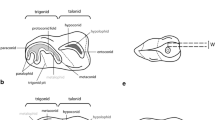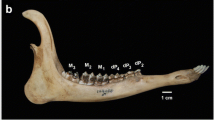Abstract
Erythrocebus patas has a short inter-birth interval, juveniles become independent from their mother early, females are young at first birth, and adult females have a high mortality rate. According to Schultz’s rule, the molars of fast-growing and shorter-lived primate species erupt early relative to the replacement teeth. Based on the life history of E. patas, we hypothesized that the molars would erupt before the replacement teeth and/or that the eruption time of its molars would be early. The purpose of the present study was to determine the dental eruption sequence and eruption times for E. patas and to test our hypothesis. The eruption sequence for the permanent teeth of E. patas is \( \frac{{{\text{M1}}\;{\text{I1}}\;{\text{I2}}\;{\text{M2}}\;{\text{P3}}\;{\text{P4}}\;[{\text{C}}\;{\text{M3}}]}}{{{\text{M1}}\;{\text{I1}}\;{\text{I2}}\;{\text{M2}}\;{\text{P4}}\;[{\text{P3}}\;{\text{C}}]{\text{M3}}}} \) in males and \( \frac{{{\text{M1}}\;{\text{I1}}\;{\text{I2}}\;[{\text{M2}}\;{\text{P4}}\;{\text{P3}}\;{\text{C}}]{\text{M3}}}}{{{\text{M1}}\;{\text{I1}}\;{\text{I2}}\;[{\text{M2}}\;{\text{P4}}\;{\text{P3}}\;{\text{C}}]{\text{M3}}}} \) in females. Because these sequences constitute the general pattern seen in cercopithecines, Schultz’s rule could not be applied to E. patas. The emergence time of upper and lower first molar (M1) is earlier in E. patas than in macaques, baboons, and mandrills and is similar to that in Chlorocebus aethiops. The emergence time of deciduous upper and lower fourth premolar (dp4) is similar to that in the above-mentioned cercopithecines but is later than that in Ch. aethiops. The emergence times of upper and lower second molar (M2) and upper and lower third molar (M3) in E. patas are earlier than those in the above-mentioned cercopithecines but later than those in Ch. aethiops. However, the intervals of the emergence time between each permanent molar in E. patas are similar to those of the above-mentioned cercopithecines. The early appearance of M2 and M3 in E. patas is related to the short interval of emergence time between dp4 and M1.



Similar content being viewed by others
References
Bolwig N (1963) Bringing up a young monkey (Erythrocebus patas). Behaviour 21:300–330
Cheney DL (1981) Intergroup encounters among free-ranging vervet monkeys. Folia Primatol 35:124–146
Cheverud JM (1981) Epiphyseal union and dental eruption in Macaca mulatta. Am J Phys Anthropol 56:157–167
Chism J (1986) Development and mother-infant relations among captive patas monkey. Int J Primatol 7:49–61
Chism J, Rowell TE (1988) The natural history of patas monkeys. In: Gautier-Hion A, Bouliere F, Gautier J (eds) A primate radiation: evolutionary biology of the African guenons. Cambridge University Press, New York, pp 412–438
Chism J, Rowell TE, Olson DK (1984) Life history patterns of female patas monkeys. In: Small M (ed) Female primates: studies by women primatologists. Alan R Liss, New York, pp 175–190
Godfrey LR, Samonds KE, Wright PC, King SJ (2005) Schultz’s unruly rule: dental developmental sequences and schedules in small-bodied, folivorous Lemurs. Folia Primatol 76:77–99
Groves CP (2005) Order primates. In: Wilson DE, Reeder DM (eds) Mammal species of the world. Smithsonian Institution, Washington, pp 111–184
Harvati K (2000) Dental eruption sequence among colobine primates. Am J Phys Anthropol 112:69–85
Honjo S, Cho F (1977) Macaques (genus Macaca). In: Tazima Y (ed) Laboratory animal science, vol 3. Asakura Publishing Co. Ltd, Tokyo, pp 312–346 (in Japanese)
Hurme VO, van Wagenen G (1961) Basic data on the emergence of permanent teeth in the rhesus monkey. Proc Am Phil Sot 105:105–140
Isbell LA, Young TP, Jaffe KE, Carlson AA, Cahcellor RL (2009) Demography and life histories of sympatric patas monkeys, Erythrocebus patas, and vervets, Cercopithecus aethiops, in Laikipia, Kenya. Int J Primatol 30:103–124
Iwamoto M, Hamada Y, Watanabe T (1984) Eruption of deciduous teeth in Japanese monkeys (Macaca fuscata). J Anthrop Soc Nippon 92:273–279
Iwamoto M, Watanabe T, Hamada Y (1987) Eruption of permanent teeth in Japanese monkeys (Macaca fuscata). Primate Res 3:18–28
Kahumbu P, Eley RM (1991) Teeth emergence in wild olive baboons in Kenya and formulation of a dental schedule for aging wild baboon populations. Am J Primatol 23:1–9
Lampel G (1962) Variationsstatistische und morphologische uutersuchungen am gebiss der cerecopithecinen. Acta Anat 49 (Suppl 45). S Karger, Basel
Macho GA (2001) Primate molar crown formation times and life history evolution revisited. Am J Primatol 55:189–201
Nakagawa N, Ohsawa H, Muroyama Y (2003) Life-history parameters of a wild group of West African patas monkeys (Erythrocebus patas patas). Primates 44:281–290
Ockerse T (1959) The eruption sequence and eruption times of the teeth of the vervet monkey. J Dental Assoc S Afr 14:422–424
Phillips-Conroy JH, Jolly CJ (1988) Dental eruption schedules of wild and captive baboons. Am J Primatol 15:17–29
Schultz AH (1935) Eruption and decay of the permanent teeth in primates. Am J Phys Anthropol 19:489–581
Seier JV (1986) Breeding vervet monkeys in a closed environment. J Med Primatol 15:339–349
Setchell JM, Wickings EJ (2004) Sequences and timing of dental eruption in semi-free-ranging mandrills (Mandrillus sphinx). Folia Primatol 75:121–132
Sirianni JE, Swindler DR (1985) Growth and development of the pigtailed macaque. CRC Press, Inc, Boca Raton
Skinner JD, Chimimba CT (2005) The mammals of the Southern Africa sub-region, 3rd edn. Cambridge University Press, New York
Smith BH (1989) Dental development as a measure of life history in primates. Evolution 43:683–688
Smith BH (1992) Life history and the evolution of human maturation. Evol Anthropol 1:134–142
Smith BH (1994) Ages of eruption of primate teeth: a compendium for aging individuals and comparing life histories. Am J Phys Anthropol 37:177–231
Smith BH (2000) “Schultz’s rule” and the evolution of tooth emergence and replacement patterns in primates and ungulates. In: Teaford MF, Smith MM, Ferguson MWJ (eds) Development, function, and evolution of teeth. Cambridge University Press, New York, pp 212–227
Swindler DR (2002) Primate dentition: an introduction to the teeth of non-human primates. Cambridge University Press, Cambridge
Thorington RW, Vorek RE (1976) Observations on the geographic variation and skeletal development of Aotus. Lab Anim Sci 26:1006–1021
Tosi AJ, Detwiler KM, Disotell TR (2005) X-chromosomal window into the evolutionary history of the guenons (Primates: Cercopithecini). Mol Phylogenet Evol 36:58–66
Acknowledgments
We would like to thank Dr. Daisuke Shimizu of the Japan Monkey Centre and Professor Masanaru Takai of the Primate Research Institute, Kyoto University, for granting permission to examine the materials used in this study and giving helpful comments. We would also like to thank the staff at the Japan Monkey Centre, and the staff at the Primate Research Institute, Kyoto University. This study was supported by the Cooperation Research Program of Primate Research Institute, Kyoto University.
Author information
Authors and Affiliations
Corresponding author
Electronic supplementary material
Below is the link to the electronic supplementary material.
About this article
Cite this article
Jogahara, Y.O., Natori, M. Dental eruption sequence and eruption times in Erythrocebus patas . Primates 53, 193–204 (2012). https://doi.org/10.1007/s10329-011-0286-y
Received:
Accepted:
Published:
Issue Date:
DOI: https://doi.org/10.1007/s10329-011-0286-y




